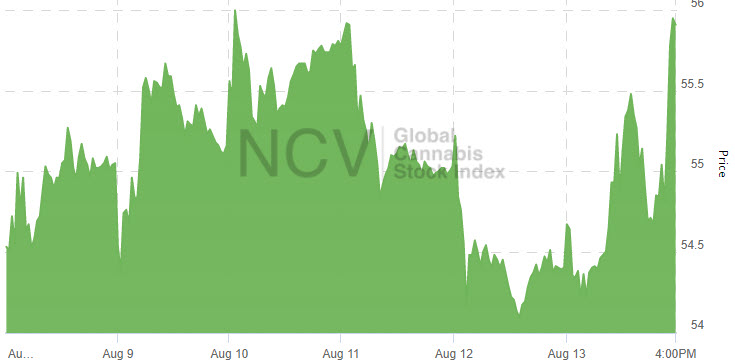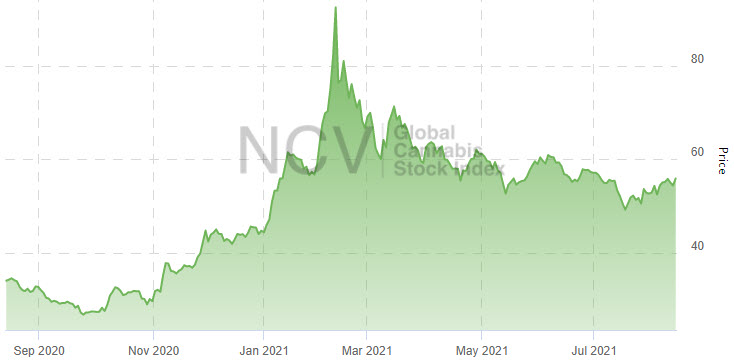Navigate the fast-moving cannabis sector with 420 Investor, a premium service that sends real-time alerts and explanations of the news below and much more.
Summary
- Data from BDSA suggested that cannabis sales slowed in June.
- Michigan sales grew 15% sequentially in July to a record $171 million.
- Health Canada added 3 new licenses, leaving the total now at 744.
- 420 Investor model portfolios have gained 30.4-70.5% year-to-date, while the Global Cannabis Stock Index has gained 26.0%.
Review
BDSA data for June pointed to the second consecutive month of slowing cannabis sales. July data from the state of Michigan showed that its market grew sharply to a record $171 million, up 15% sequentially and 56% from a year ago.
Health Canada added 3 new licenses, leaving the total at 744, including 6 that are expired, revoked or suspended.
During the week, I shared these insights with subscribers at 420 Investor:
- Model Portfolio Composition 08/06/21
- Cannabis Sub-Sector Review – 08/06/21
- Revisiting the MSOS ETF
- Earnings Previews for Alcanna, Charlotte’s Web, Columbia Care, Cresco Labs, Goodness Growth, GrowGeneration and Trulieve
Here are some of this week’s highlights for 420 Investor Focus List names:
- CCHWF began adult-use sales at its downtown Boston dispensary. It became the official CBD partner of the Professional Fighters League. Q2 combined revenue, which includes the recently closed Ohio acquisition, was $110 million, up 232% and in line with expectations.
- CRLBF doubled its debt facility to $400 million, lowering the interest rate to 9.5% and extending the term to 2026. Q2 revenue grew 123% to $210 million, ahead of the expectations.
- CURLF exceeded expectations as it reported Q2 revenue of $308 million, up 166%
- CWBHF Q2 revenue grew 11% to $21.7 million
- FFLWF partner Fire & Flower U.S. Holdings opened its first dispensary in California
- GDNSF added Josh Rosen as a director. Its Q2 was slightly better than expected at $14.2 million, which was up 45% adjusting for dispositions of assets
- GNLN sold $32 million of units at $3.16 that included warrants at $3.55
- GRAMF filed its Form 10 with the SEC. It opened its 5th store in California
- GRWG Q2 revenue of $126 million grew 190% and was ahead of expectations, though its boosted guidance of $455-475 million disappointed investors given all of the recent acquisitions
- GTBIF opened its 16th store in Pennsylvania. Q2 revenue of $222 million, up 87%, exceeded expectations
- HRVSF exceeded expectations with Q2 revenue growing 84% to $102.5 million. Its shareholders approved the merger with Trulieve, though it is not expected to close until early 2022.
- LQSIF reported cannabis revenue (Nova Cannabis) of C$29.7 million as its Value Buds strategy is quickly paying off
- SMG announced a $150 million investment into RIV Capital, which will downlist to the CSE and make direct investments in the U.S., through a new subsidiary, The Hawthorne Collective. The convertible note gives it 42% control over RIV Capital and had a conversion price just 7% above the price of the stock prior to the announcement. The company also borrowed $400 million for 11 years at 4.375%
- TCNNF opened its second dispensary in Massachusetts and 88th in Florida. Q2 revenue exceeded expectations as it grew 78% to $215 million
- TLLTF won provisional adult-use licenses in Massachusetts. It announced 1906 as a partner in all three of its states.
- UGRO reported Q2 revenue of $12.8 million, up 220%, and shared full year guidance for revenue to be $54-59 million with adjusted EBITDA of $4-5 million.
- VFF Q2 cannabis revenue was strong, growing 41% sequentially to $24.8 million with an adjusted EBITDA of $7.4 million
- VLNCF announced new vape offerings and beverages from partner Verse Cannabis
- VRNOF reported Q2 revenue of $198.7 million, up 320%. It opened its 36th dispensary in Florida.
The Global Cannabis Stock Index made it four consecutive weekly increases, driven by just a few stocks with outsized gains, increasing 1.6% to 55.91:
 The index, which lost 34.1% in 2019 and lost 54.9% in 2018 after gaining 91.8% in 2017 and 88.8% in 2016, was up 5.2% in 2020. It has gained 26.0% in 2021 thus far. It currently includes 44 stocks and ended 2020 at 44.39:
The index, which lost 34.1% in 2019 and lost 54.9% in 2018 after gaining 91.8% in 2017 and 88.8% in 2016, was up 5.2% in 2020. It has gained 26.0% in 2021 thus far. It currently includes 44 stocks and ended 2020 at 44.39:
 Model Portfolios
Model Portfolios
420 Investor offers three model portfolios for subscribers, including two that are long-term focused and fully invested with a goal of beating the Global Cannabis Stock Index, 420 Opportunity and 420 Quality. 420 Opportunity ended the week valued at $149,815, down 3.1%. The model portfolio, up 42.2% in 2021, gained 35.6% in 2020 and has increased 199.6% since April 2014. 420 Quality ended the week at $210,555, down 3.3% for the week, and is now up 30.4% in 2021 after gaining 42.8% in 2020. The model was launched in March 2017 targeting long-term investors seeking to invest in leading cannabis stocks with low portfolio turnover and has gained 321.1% since inception compared to the 30.9% decline in the index. Flying High, which is focused on swing trades, ended the week valued at $430,322, down 1.9%. The model portfolio gained 52.7% in 2020 and is up 70.5% in 2021, and the return since inception in late 2013 has been 4203%.
Outlook
After a strong rally to begin 2019, the cannabis sector experienced a sharp decline over the next year to unprecedented levels due to several negative developments, including the CannTrust fraud, the surprise termination of Bruce Linton as CEO of Canopy Growth, a disappointing roll-out of legalization in Canada, regulatory confusion in the U.S. regarding CBD and a slow roll-out of legalization in California, the vaping crisis and then financial turmoil and market disruptions due to the COVID-19 pandemic. The sector saw capital available to fund expansion dry up, a situation that continues to leave companies operating with negative cash flow severely challenged, as the availability is limited to stronger operators.
Cannabis stocks overreacted and put in a bottom in March 2020, and they are now benefiting from a perception that the industry offers strong growth prospects, something that wasn’t clear then. A big change has been that the pandemic caused many regulators to permit previously prohibited types of retail activities, like curbside pickup and delivery. The legal market is rapidly capitalizing on becoming even more convenient than the illicit market, with the ability to order online. High unemployment and large deficits have begun to spur state legalization efforts as well as more favorable regulatory control at the local level. Access to capital has improved dramatically, and the leading companies are generating large and rapidly growing revenue and profits.
There are several potential catalysts ahead, including the FDA providing clarity on CBD regulation, progress in the Canadian legalization that commenced in October 2018 and that is beginning to include a broader set of products and the continued growth in German and Israeli MMJ and other international markets that have been slow to develop. The adult-use implementations in California and Massachusetts for adult-use were slow to roll out but are beginning to show great improvement. Michigan and Illinois legalized for adult-use at the end of 2019, and these markets are showing strong growth that could encourage other states to legalize. Voters in Arizona, Montana, South Dakota and New Jersey all approved adult-use legalization in November, and New Mexico, New York and Virginia have enacted legalization through the legislative process in 2021.
The big themes ahead are likely to be continued cross-industry investment into the sector and more consolidation in Canada and in the U.S., potential federal regulatory reform (SAFE Banking Act and other more comprehensive legislation, which could eliminate 280E taxation and enable trading on higher exchanges for MSOs as well as the broad usage of credit cards for cannabis purchases), steps to enable cannabis research, the roll out of MMJ in Germany, Mexico and in Australia as well as continued advances in South America and potential adult-use legalization in Israel and Mexico, new legal cannabis implementations in AZ, MT, NJ and SD, and MMJ implementations in AL, WV and VA, possible legalization via the legislatures in DE, FL, MD, MN, NH, PA and RI and implementation of the CT, NM, NY and VT commercial programs in 2022 and VA in 2024.
